
|
|
SUBSIM: The Web's #1 resource for all submarine & naval simulations since 1997
 |
SUBSIM: The Web's #1 resource for all submarine & naval simulations since 1997 |
 02-10-07, 06:50 PM
02-10-07, 06:50 PM
|
#16 | |
|
Watch
 Join Date: Jan 2007
Location: Far end of the world...
Posts: 30
Downloads: 2
Uploads: 0
|
Quote:

__________________
"Some ships are designed to sink… others require our assistance." "When you shoot at a destroyer and miss, it's like hit'in a wildcat in the ass with a banjo” |
|

|

|
 02-10-07, 06:57 PM
02-10-07, 06:57 PM
|
#17 |
|
Chief
 Join Date: Jan 2007
Location: U-33. Depth Charges...sinking..
Posts: 325
Downloads: 0
Uploads: 0
|
If you are playing GWX and go to your Nav screen (F5), hit the question mark tool and then the marker and you should have a little scale appear next to your cursor which may help in determining depth.
Personally though, I still have a hard time discerning between "ciridian blue" and Aquamarine, so I have to rely on my XO (the wife) to decipher my map...  
__________________
The new-moon night is black as ink. Off Hatteras the tankers sink. While sadly Roosevelt counts the score-- Some fifty thousand tons--by MOHR |

|

|
 02-10-07, 07:39 PM
02-10-07, 07:39 PM
|
#18 |
|
Captain
 Join Date: Jan 2007
Location: Tennessee
Posts: 546
Downloads: 17
Uploads: 0
|
I managed to et away by staying close to land and beaching em, then heading back into scapa to exit the mission
__________________

|

|

|
 02-10-07, 08:10 PM
02-10-07, 08:10 PM
|
#19 | ||
|
Lucky Jack
 |
Quote:
__________________
“You're painfully alive in a drugged and dying culture.” ― Richard Yates, Revolutionary Road |
||

|

|
 02-10-07, 08:26 PM
02-10-07, 08:26 PM
|
#20 | |
|
Ocean Warrior
 Join Date: Jul 2006
Location: Reading UK
Posts: 3,473
Downloads: 90
Uploads: 0
|
Quote:
 I would say run silent and run deep but in these kind of situations there is not much you can do. Just keep racing towards deep waters and pray. Pray a LOT
__________________
 http://www.thegreywolves.com/ http://wolvesatwar.com/ Download GWX and other goodies: http://hosted.filefront.com/melnibonian |
|

|

|
 02-10-07, 08:40 PM
02-10-07, 08:40 PM
|
#21 |
|
Admiral
 Join Date: Apr 2005
Location: Australia:- Sydney
Posts: 2,049
Downloads: 68
Uploads: 0
|
U-Boat Evasive Tactics
A U-boat’s best defense is concealment. But once this is blown, the next best recourse is to dive immediately. Ironically, if a U-boat is spotted on the surface, the first thing the escort will do is to shell it immediately and force it to submerge. This will break up the attack sequence and neutralize any threats of torpedo attacks. If given the opportunity, escorts will even ram a U-boat, whether it is on the surface or at periscope depth. The resulting damage will put the escort out of action for many months, but if that could sink a U-boat, then the price was considered well worth it. 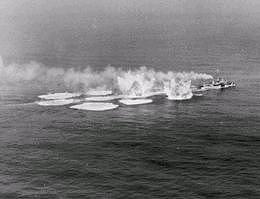 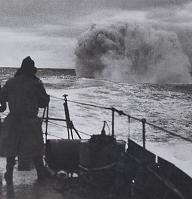 A destroyer launching a tight pattern of depth charges. Launching depth charges was much a matter of guesswork. Sailors watched for underwater explosions and looked for debris for evidence of a kill. Once spotted, a U-boat requires at least 30 seconds to crash dive to a depth deep enough to evade the resulting depth charges. If the attacking vessel is too close, it might have better chances running on the surface to build up sufficient speed before ordering a crash dive. A U-boat can outrun most escorts, including corvettes, but not modern destroyers. Once underwater, the cat and mouse hunt begins. The escort will be searching for the U-boat by listening in to the hydrophones and pinging with its sonar. On the U-boat, the hydrophone operator too will be listening in for the escort’s screws. He will be able to determine the location, speed and the type of ship (merchant or warship) on the surface. These will provide the only clues as to the activity on the surface. Depth reduces the effectiveness of sonar. The deeper the U-boat, the more difficult it is to locate. A good evasive measure is to dive as deep as possible and as quickly as possible. This not only reduces the sonar signature, but also provides more time to evade depth charges and will keep the enemy guessing on the U-boat’s location by the time the depth charge reached the desired depth. Also, since sonar is more effective when pulsed at flat surfaces, a skilled commander will try to keep its bow or stern pointed towards the attacker as much as possible. U-boats are capable of very silent operations. But in order to remain undetected, it had to move very slowly underwater, which meant a low speed of only 2 knots. If this was not silent enough, the commander could further order the boat to run on silent mode. In this mode, all non essential activities are halted. Torpedo tubes are not reloaded, bilge pumps are run by hand and all non essential personnel are sent to the bunks. Silent operation keeps the U-boat’s noise low, and also helps to conserve battery power. 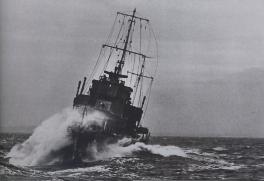 Given the opportunity, escorts captains won't think twice about ramming a U-boat. There are several occasions when an escort will lose contact with a submerged U-boat. During the explosion of a depth charge, an intermittent blackout occurs, deafening the pursuer’s listening devices until they calibrate themselves. When the escort passes directly above a submerged U-boat, both sonar and hydrophone contacts are lost. Sonar is useless at short ranges and in addition, the U-boat’s position would be out of the sonar’s arc of detection when the ship passes directly above. Also, due to the interference of the ship’s own propeller noise, hydrophones cannot pick up any sound coming directly from astern of the ship. This provided several window of opportunities for a U-boat to change course or to run at high speeds without being detected. U-boats could also launch BOLD canisters to confuse their attackers. Consisting of a chemical compound which emitted large quantities of gas, the resulting bubble cloud could resemble a submerged U-boat. Unless the sound operator was especially skilled, it was often difficult to distinguish it from a real U-boat. The allies called this a “Submarine Bubble Targer” (SBT). It was not an easy task locating and attacking a submerged U-boat. Much skill and persistence was needed, and was especially so if the U-boat had already dived very deep beneath the sea. Sometimes escorts forced a U-boat to the surface by waiting it out. Since U-boats had very low underwater speed, escort captains knew that it could not travel very far. In addition, it could not remain submerged for very long periods. Appreciating the fact that carbon dioxide levels will start to rise, escorts will often wait in silence until the U-boat was forced to surface by itself due to the lack of breathing air. During the war, more than a handful of U-boats were defeated by sheer patience. "Don't you dare give up Captain, you have more than enough tactics to evade the enemy above". |

|

|
 02-10-07, 08:54 PM
02-10-07, 08:54 PM
|
#22 |
|
Ace of the Deep
 Join Date: Oct 2006
Location: Los Angeles, Ca
Posts: 1,142
Downloads: 267
Uploads: 0
|
Praying is a good thing........best of luck

__________________
 Crew member/ decommission member TM2(SS)(SD) 3/68-7/70 Crew member/ decommission member TM2(SS)(SD) 3/68-7/70 DIESEL BOATS FOREVER USS SEGUNDO (SS398) DIESEL BOATS FOREVER USS SEGUNDO (SS398)
|

|

|
 02-10-07, 08:58 PM
02-10-07, 08:58 PM
|
#23 |
|
Admiral
 Join Date: Apr 2005
Location: Australia:- Sydney
Posts: 2,049
Downloads: 68
Uploads: 0
|
Remaining Invisible
The most vital asset of a U-boat is the element of surprise. A U-boat possess an exceptional ability to attack and withdraw without being detected. For this, a skilled commander must make every effort to ensure that his boat remains unseen. In U-boat school, commanders are guided by the principle, “He who sees first, has won!”. This is especially true, in order to prevent the boat from being sighted. Thus, it is of paramount importance that sharp lookouts be posted when operating on the surface. Keeping a vigilant lookout is tiresome, consequently, crews on watch duty should be punctually relieved by the next shift. Four lookouts are posted on the bridge, each systematically organized to scan a 90 degree sector of the U-boat. The horizon is scanned for ships, or for smoke on the horizon, indicating an impending ship. The sea surface is scanned for periscopes and the sky for aircraft. Under no circumstances are lookouts allowed to deviate from their duty. Even during a deck gun engagement, lookouts are not allowed to witness the battle, for fear that the U-boat might be surprised by a lurking enemy. Particular attention should be paid to the sun sector, as visibility is always impaired when looking into the sun’s direction. 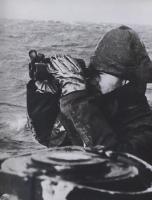   Four lookouts scanned the horizon, which was divided into four zones of 90 degrees each. From the air, it is the wake of a U-boat which is spotted first, rather than the boat itself. Posting a lookout on a raised periscope. When cruising on the surface, care should be exercised not to raise the periscope, especially during daylight. When submerging, the periscope should be raised only after the boat has completely submerged. In the same manner, the periscope should be completely lowered before breaking the surface. In clear weather, a lookout with binoculars can be hoisted up on a raised periscope for an all round view, but this should be used sparingly as the dangers are two fold; it takes much longer to crash dive in the event an enemy aircraft is spotted, and a U-boat with a raised periscope is much easier to spot. As a principle, in clear weather, it is always better to submerge too early, than to submerge too late. At the latest, a U-boat must submerge when the funnel top of the enemy ship is sighted. Warships often have lookout posts on the top of his masts, who are not only equipped with powerful binoculars, but also range finders with powerful optics. The dangers of being sighted are too easily underestimated. In poor visibility, it would be better to submerge as the hydrophones can detect ships much further than the lookout can see. However a U-boat’s place is on the surface and as soon as the weather permits, the U-boat must surface. By characteristic of a submerged U-boat, it is slow and blind, and leads to passivity and lost opportunities of attack. Furthermore, a U-boat should not remain in the vicinity of where it had submerged. Traces of diesel may be left behind when ballast tanks are flooded, and it is best to sail to another location. When submerged and stalking the enemy, it is safe to raise the periscope at 4,000 to 5,000 meters from the enemy. At closer distances, the periscope must be used sparingly, exposing the tip only intermittently and while traveling at low speeds to create less of a wake. Before surfacing, an all round sound sweep must be performed at a depth safe from ramming (approx 20 meters). The U-boat then surfaces to periscope depth, an all round periscope scan is performed with and without magnification. When all is clear, break surface at high speed. The commander and a lookout rushes aboard and a thorough all-round scan is performed. Only then, it is safe to completely empty the ballast tanks of water. 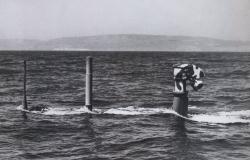 The wake of the periscope is less visible when travelling slowly, or in choppy seas. As for air attacks, the best defense against aircraft is to spot it in time and crash dive to safety. Unless otherwise confirmed, every aircraft sighted should be treated as hostile. In clear weather, it is better to remain on the surface and keep a vigilant lookout for aircraft. Although the dangers of air attack exists, it is possible to spot the aircraft in time than to remain submerged and lose valuable opportunities of attack. In low visibility, or on days with thick could cover, it might be advantageous to submerge to prevent surprise air attacks. Visibility conditions from within an aircraft isn’t any better. It is very difficult to spot a U-boat from the air, and more often than not, it is the wake of the boat which is spotted first, rather than the boat itself – particularly if the boat is cruising at high speed. A U-boat is particularly difficult to spot when sailing on choppy waters and wavy seas, rather than on calm seas. Turbulent sea conditions, such as those in the Baltic, the Mediterranean and near river mouths therefore present better cover for U-boats. When submerged, it becomes very difficult, but not impossible to sight a U-boat. On clear weather, when the sun pierces into the water, on a calm sea, and with the aircraft flying almost directly overhead, it is still possible to spot a submerged U-boat. However, without these ideal conditions, a submerged U-boat would be safe from aircraft detection. Don't give up Captain ! 
|

|

|
 02-10-07, 09:03 PM
02-10-07, 09:03 PM
|
#24 |
|
Fleet Admiral
 |
How fare out of the entrance are you? If you are still close to the Eastern entrance, head back towards the blockships! I know this sounds counterintuitive, but the AI is dumbe enough to let the DD's chase you in straight on pursuits so if you can get them close enough they will grind themselves against the block ships.
If not keep as low and as slow as you can and I use around a 10 degree alternation on the rudder going port to starboard everyso often. I was using this to reasonable success just outside Darwin until a bugger with a Hedgehog came around and dropped a cluster right on top of me! 
|

|

|
 02-10-07, 09:35 PM
02-10-07, 09:35 PM
|
#25 |
|
Seaman
 Join Date: Feb 2007
Posts: 41
Downloads: 0
Uploads: 0
|
Here is what I will add in my limited experience:
I get regular depth reports, especially if I'm expecting contact with a destroyer (eg I sink a ship or they are in the area). Helps to know just how much depth you have to play with, before they're close enough to hear you. I get regular updates on the position of the destroyer, manually if I have to. I mark the positions on the nav map, as destroyers like to circle an area, move, circle another area, move etc it gives an idea of what direction you should run off to.
Ignore the depth charges unless they are obviously close. Unless you can hear him on top of you then you aren't in any danger, this is at least for medium depths (don't know whether you can hear them at greater depths). Best way is preventitive I think. As soon as they are closing or you fire your torpedo, move quickly from your location. |

|

|
 02-10-07, 09:48 PM
02-10-07, 09:48 PM
|
#26 | |
|
Navy Seal
 Join Date: Nov 2006
Location: Docked on a Russian pond
Posts: 7,072
Downloads: 2
Uploads: 0
|
Quote:
Congratz, Mate. When you return to base , we got to crack the champagne, head for Paris and have a wild night at the Scheherezade.   
__________________
Espionage, adventure, suspense, are just a click away Click here to look inside Brag's book: Amazon.com: Kingmaker: Alexey Braguine: Books Order Kingmaker here: http://www.subsim.com/store.html For Tactics visit:http://www.freewebs.com/kielman/  |
|

|

|
 02-11-07, 01:13 PM
02-11-07, 01:13 PM
|
#27 |
|
Ocean Warrior
 Join Date: May 2005
Location: New Castle of Delaware
Posts: 3,231
Downloads: 658
Uploads: 0
|
Here's a way to evade:
When you attack a merchant dive and go deep as fast as possible turning away from your attack course, and go Silent... the DDs seem to know where you are when you fire. (That's how they are in my career so far... Nov 1940) Once you're below 130 meters, slow to 1kt. If the DD still has you and is circling, head off in another direction to get out of his circling path. If you can do that and he passes you by stop engines and sit still. Have your stern facing him during this if you can. Once he's turned tail to you start moving at 1kt again. When he's getting ready to face you again, stop and sit. This might take an hour or to 2 get far enouch away from him but eventually you be past his sonar range. Once out of his range, if he keeps on his present track you'll be able to increase speed to 2 kts and stretch your margine of safety. If you get "he's pinging us", just sit tight as it doesn't necessarily mean he knows where you are, he's only is trying to pick you out. Plus the "thermal layers" are helping mask you. I just went thru this with a Black Swan DD in BE3. It took me 2 1/2 hours in real time, but I escaped without a scratch.
__________________
Gary No Borders, No Language, No Culture =s No Country I'm a Deplorable, and proud of it. |

|

|
 |
|
|
